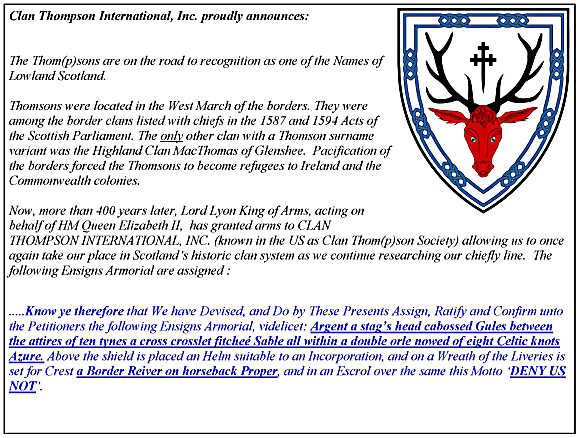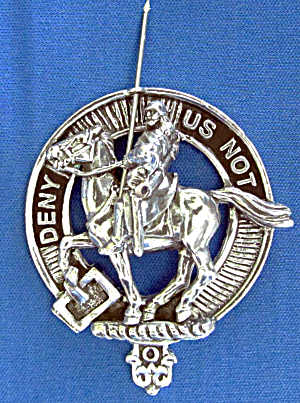|


A BRIEF HISTORY OF CLAN THOMSON
There was no single originating family
named Thomson responsible for all the Scottish Thom(p)sons found today.
The name is patronymic, in that the next generation is named after the
father’s personal name. Although many have been linked by the Thompson
DNA project. Thomsons are very numerous over a large part of Scotland
and are primarily found south of the Forth and Clyde. The lowlands or
border lands are neither purely English nor purely Scottish. In fact,
the border lands and the region known as Lothian just north of the
border have now become the center of Scotland with Edinburgh as it’s
capital.
The earliest Thomsons; spelled with an
(a), (e), and sometimes a (p), slowly evolved from the 12th century into
families with a central head or leader in the border and Lothian areas
of the Scottish lowlands from Dunfriesshire to Rosburghshire.
The Thomsons of Eskdale were a rather small fifteenth-century clan
closely aligned with the larger clans Beattison snd Nixons. In the
1540’s the English Lord Wharton reported to the Earl of Shewsbury that
the Batysons, Thomsons, and Lytles of Esskdayle have made raiding (reiving)
forays on several English towns.
In
1547 the English Lords Lennox and Wharton crossed the Esk River to
subdue the south of Annandale and Castlemilk. The continuing reiving on
the borders resulted in several lairds and clans being forced to give an
oath of obeisance to the King of England. Bell’s MS, preserved in the
Carlisle Cathedral Library, lists the names of 166 Beatties and Thomsons
who had surrendered to the English King. The 1551 peace accord created
the Debatable Lands between the Esk and Sark rivers which belonged to
neither kingdom.
The farmers of the fertile plains of
Berwickshire and the middle Tweed valley saw themselves as different
from the horsemen of Liddesdale. In 1569 the lairds of the eastern and
middle marches asserted that, while they themselves were peaceable, the
thieves of the western ranges were not. In a memorandum to the Scottish
Privy Council, they insisted that reivers must be controlled. They
produced a black list of the surnames of the worst offenders: All
Armstrongs, Batesons, Bells, Crosiers, Elliots, Glendinnings, Hendresons,
Irvines, Nixons, Routledges and Thomsons.
“The Steel Bonnets” by George MacDonald
Fraser has a list of reivers he calls the riding surnames. In the west
march the ‘Nixons’ were located on the upper Liddesdale, Bewcastle, Line
rivers. Less compact than the Armstrongs, they were important enough to
have Thomson, Glendennings, and Hunters associated with them. Like other
Liddesdales clans, they sometimes allied with England. In the Middle
March, Fraser listed the Thomsons as riding with the English.
In
1581, The Scottish Parliament rendered a whole clan jointly answerable,
in the way of retaliation for the delinquencies of each individual. In
another statute passed shortly thereafter, the chief of each clan was
made responsible for all the misdeeds of his surname. In consequence of
these acts, in 1587, a roll was made of the nobles, barons, chieftains
and clans residing in the Borders, Isles and Highlands. In this roll of
the clans with chiefs in the West March appear the surnames: Scotts of
Ewesdale, Batesons, Littles, Thomsons, Glendinnings, Irvings, Bells,
Carruthers, Grahams, Johnstons, Jardines, Moffats, and Latimers. In
addition, Monypeny’s Chronicle, published in 1587, enumerates sixty-five
Lairds and gentlemen as residing in Dumfriesshire. There were also
twenty “chief men of name, not being Lairds,” among which are included
Young Archie Thomson and Sym Thomson.
“The Scotch-Irish”, by Charles A. Hanna,
1902, lists Thomsons, Battison, and Beattie as border clans located in
Eskdale in 1547. Fifty years later, he notes the Thomson clan has
relocated to Annandale along with Irving, Bell, Carlye, Graham, et al,”
A 1594 Act of the Scottish Parliament
for the “punishment of theft, robbery and sorning lists the clans….
Bells, Carlisles, Beatsons, Littles,
Thomsons Johnstons, et al.
At
the union of the crowns in 1603, King James VI of Scotland left Scotland
for London as King James I of a United Kingdom. He was determined
to put down the continuing lawlessness on both sides of the border. His
wishes were carried out through with sword, noose and torch until hardly
a building stood in the whole of Eskdale and Liddesdale. Chiefs were
hanged, those who survived were later ordered to sell out.
The clans began to scatter in the 17th
century. Littles, Beatties, Thomsons, Elliots, Armstrons and Irvings
fled from persecution, poverty and overcrowding to the Ulster
plantations. Many moved later into neighboring English Cumberland, and
crossed the oceans to North America, Australia, Canada, and New Zealand,
proud of their origins, but over the generations losing contact with the
descendants of those who stayed behind.
Tartan: The Scottish Register of Tartans
has listed this information note: The Thomson Dress Blue has been
adopted by the Clan Thom(p)son Society as the official Clan Society
tartan and worn by many Thomsons regardless of spelling. The Clan
Thom(p)son Society also wear the Thomson Hunting, Grey Dress, and Camel
tartans.
Thompson Walls Historic site. The site
is described as a Pele Tower. Nothing visible remains. The tower appears
on 1584 ‘plan’ by Dacre, though apparently this map illustrated houses
he would like to see built as well as those standing. The name Thompson
Walls has lasted through, suggestive of a structure, and a long history
is given of ownership. The site was a barren waste in 1541 with farming
development planed. Antechester is a DMV.
Informational notes: The claim that Thomson
is an anglicized form of MacTavish is inaccurate. Consider these common
sense facts:
· The Argyll Hearth Tax Roll of 1694
lists Donald MacCombis and a single tenant (Brown) as living on Dunardry.
If there was a MacCombis (MacTavish) clan it would have consisted of
only these two individuals. In fact, the tax roll has a total of only 17
MacCombis is all of Argyll. The spelling evolution resulting in the
surname MacTavish on Dunardry went from VcCauus, to VcKavissl, to
MacCawis, to Dugald McTavish on/about about 1720, as son and heir of
Archibald McCzawis.
· MacTavish is anglicized from the
Gaelic McCawis. How can you further anglicize an English name?
· If all 17 (1694 Argyll Hearth Tax
Roll) of the MacCombis scattered throughout all of Argyll changed their
names to MacTavish, their number would not begin to compare with the
numbers of Thomsons living in the lowlands where they had flourished for
hundreds of years as Thomsons.
· King James pardoned, by name, 40
fighting men with the Thomson surname riding with John [Maxwell], Earl
of Morton for all crimes committed between 1569 and 1585. Common sense
tells us that 40 Thomsons of fighting age, from Eskdale, recorded more
than 100 years before there even was a name MacTavish cannot be
descended nor connected to a wee family in Argyll.
· The McCombis were not included in
the 1587 roll of clans because a handful of related individuals does not
make a clan.
· A chief can only be the head of
ONE family surname. The chief of Clan MacTavish is only the legitimate
chief of the clan and name MacTavish.
· The Scottish Parliament repeatedly
recognized MacThomas and Thomson as two separate and individual
names/clans already present in the 1500s. Thomson and MacThomas are
both derivitives of 'Thomas.' Lord Lyon has formally recognized three
distinct names: Clan MacThomas of Glenshee, Clan MacTavish and Clan
Thompson International. In the 21st century, these three names cannot be
co-mingled or interchanged. An individual named MacThomas is no more a
member of Clan Thompson International than he is a member of Clan
MacTavish and so on.
THOMSON: This name means literally 'son of Thom or Thomas,' and it should be noted that its prevalence throughout the British Isles clearly shows that Thomas had been a popular forename from the Middle Ages. Consequently, many families of differing origins now bear this name. Thom(p)son tends to be an English form, and Thomas is usually Welsh. The most eminent families, were found about Edinburgh where those of Duddingston held their lands until about 1688, and those of Corstorphine had long association with the Forrester lairds of that place. Thomson is also an anglicized form of MacTavish, MacThomas and MacComie. The MacTavishes of
Argyll are said to derive from 'Taus Coir' an illegitimate son of a Lord of Lochow who lived about the beginning of the 13th century, but many of these have now changed their name to Thomson or Taweson. The Clan MacThomas of Glenshee (Perthshire), were originally MacComies who took their name from Thomas, a son of the 6th Chief of Mackintosh who settled there in the 15th century and from where many of his descendants became established in Angus and the surrounding counties. Although MacThomas remains the official name of that clan, having appeared as such in the Rolls of Clans compiled in 1587 and 1594, it is remarkable that few of its members have ever borne the name. Clan associations may therefore lie with the MacTavishes or MacThomases, and it is possible that some Thomasons are linked with Clan MacFarlane, for some are said to descend from Thomas, a son of a MacFarlane chief, who lived about 1390-1406. The name Maclehose is reputed to be of similar origin and is found in Argyll and areas adjacent to lands occupied by MacThomases and MacFarlanes. In 19th century Scotland Thomsons advanced the cause of Arts, Science and Invention beyond the 'per capita' endeavours of any other name - one patented a pneumatic tyre as early as 1845 and later, William Thomson, Lord Kelvin, gave his name to the scale of degrees Kelvin. In the absence of genealogical or geographical evidence of clan association, suitable tartans would be the Dress and Hunting Thomson patterns, both recorded at Lyon Court for Lord Thomson of Fleet, but now in general use.
|

